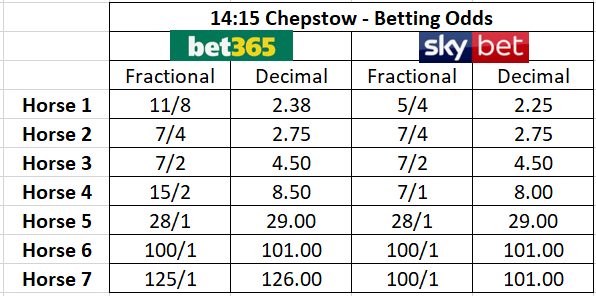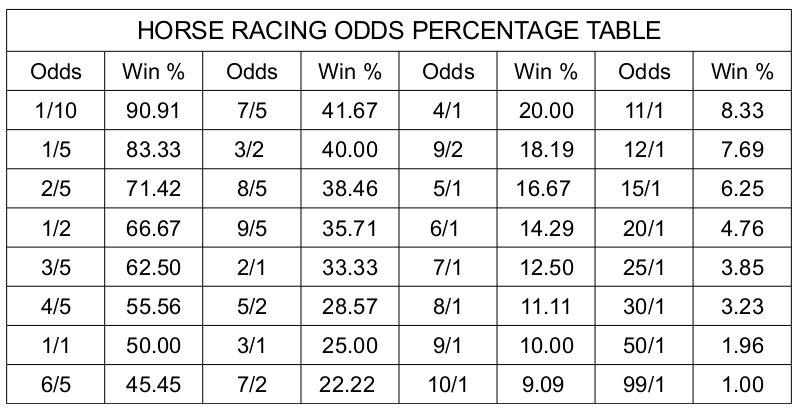Introduction
Horse Racing Betting Odds Chart: For anyone stepping into the exhilarating world of horse racing, one of the first and most important things to understand is the betting odds chart. Horse racing is not just about watching majestic thoroughbreds gallop towards the finish line it’s also about the thrill of prediction, strategy, and of course, the potential for winning big. At the core of all this lies the odds chart, which tells a story of probabilities, public sentiment, and payouts. While it might look like a jumble of numbers and fractions at first glance, once you learn to read the chart, you gain valuable insight into the race ahead. Whether you’re a casual punter placing a weekend bet or a seasoned bettor looking to refine your strategy, understanding the horse racing betting odds chart is an essential skill.
What Are Horse Racing Odds And Why Do They Matter?
At its most basic level, betting odds in horse racing reflect the probability of a particular horse winning a race. But they are also tied closely to the amount of money wagered on that horse. The odds determine how much a bettor stands to win if their chosen horse crosses the finish line first. Therefore, odds are both a reflection of a horse’s chance of winning and a guide to potential returns on your bet.
For example, if a horse is listed at 2/1 odds, it means that for every $1 you wager, you will win $2 if that horse wins—plus you get your original stake back. On the other hand, a horse with 10/1 odds is considered less likely to win, but if it does, the payout is much higher. These odds are not set in stone and can fluctuate leading up to the race based on factors such as betting volume, changes in track conditions, and new information about the horses or jockeys.

The Different Formats Of Horse Racing Odds
In horse racing, odds are most commonly displayed in three formats: fractional, decimal, and moneyline (also known as American odds). Understanding each of these formats is crucial, especially if you’re betting across different platforms or from different countries.
Fractional odds are the most traditional and are widely used in the UK and Ireland. These odds appear as fractions, such as 5/1, 7/2, or 9/4. The first number (the numerator) represents how much you will win if you bet the amount of the second number (the denominator). So with 5/1 odds, a $1 bet earns a $5 profit. This format is favored for its simplicity in conveying the ratio of risk to reward.
Decimal odds are more common in Australia, Europe, and on many online betting sites. These odds show the total return rather than just the profit. For instance, odds of 3.00 mean that a $1 bet will return $3 in total—$2 in profit plus your original $1 stake. Decimal odds are straightforward and easy to compare at a glance.
Moneyline or American odds can be either positive or negative. A positive number like +400 indicates how much profit you’ll make on a $100 bet (in this case, $400). A negative number like -150 shows how much you need to bet to win $100. While this format is more popular in sports betting within the United States, it occasionally appears in U.S.-based horse racing platforms.
How To Read The Odds Chart At The Track Or Online
When you look at a horse racing odds chart, it might resemble a stock ticker with constantly updating numbers. But once you break it down, the information is quite intuitive. Each horse listed in the race will be accompanied by its odds, which represent its current perceived chances of winning. These odds are influenced by the betting pool, and as bets come in, the odds shift to reflect the distribution of money.
Besides the odds, charts also include the horse’s number, name, jockey, trainer, and sometimes past performance data or recent finishes. This gives bettors a snapshot of key information to aid their decision. Morning line odds, which are the initial odds set by the track handicapper before betting opens, serve as a prediction of how the betting public might wager. As betting progresses, these odds will move according to the money wagered.
Favorites, Longshots, And What The Odds Tell You
Within the odds chart, the horse with the lowest odds is typically the favorite. This horse is considered the most likely to win, usually due to past performance, reputation, or insider tips. A favorite might have odds like 2/1 or even lower, such as 4/5. On the other end of the spectrum, longshots carry much higher odds like 20/1 or even 100/1. These horses are seen as unlikely to win, but when they do, they offer massive payouts.
While it might be tempting to always bet on the favorite, it’s not always the most profitable strategy in the long run. Favorites do win races, but horse racing is notoriously unpredictable. Savvy bettors often look for value bets—horses with higher odds that have a better chance of winning than their odds suggest. By analyzing form, track conditions, and other factors, these bettors seek to identify mispriced horses that can lead to better returns.

Types Of Bets And How Odds Influence Them
Understanding the odds chart also means understanding how different bet types interact with odds. In a simple “win” bet, you’re wagering that your horse will finish first. The odds directly impact your payout in this case. For a “place” bet, your horse must finish first or second, and the payout is usually smaller since the odds are adjusted. A “show” bet pays out if your horse finishes in the top three.
More complex bets include exactas (picking the first and second place horses in exact order), trifectas (first, second, and third), and superfectas (first four in order). These types of bets offer higher payouts, and the odds chart will help indicate potential risk and reward for these combinations. Because these are more difficult to predict, they often come with long odds and correspondingly larger potential winnings.
Odds Fluctuations And Live Betting Dynamics
Another key aspect of the horse racing odds chart is that it is dynamic—it can change by the minute. Odds fluctuate based on betting behavior. If a large volume of bets comes in for a particular horse, the odds for that horse will decrease to balance the payout liability. Conversely, if little money is placed on a horse, its odds will increase.
This fluctuation creates an environment of live betting, where bettors can react to changes and adjust their strategies accordingly. Experienced horseplayers monitor these shifts closely to look for windows of opportunity—situations where the odds don’t accurately reflect the horse’s true chances due to public overreaction or underestimation.
Using The Odds Chart Strategically
Reading the chart isn’t just about understanding the numbers—it’s about interpreting what they mean in a broader context. If a horse’s odds shorten significantly before the race starts, that might indicate insider knowledge or confidence among professional bettors. If the favorite drifts out to longer odds, it could suggest underlying concerns not immediately visible to the casual viewer.
By combining odds analysis with deeper research—such as the horse’s recent form, the jockey’s track record, and track conditions—you can develop a more nuanced betting approach. Some bettors use odds to identify overlays, where the perceived value of a horse exceeds its posted odds. In contrast, underlays are horses that are overbet and offer little return for the risk involved.
Technology And The Modern Odds Chart
In the digital age, horse racing betting odds charts are now easily accessible online through sportsbooks, racing apps, and betting exchanges. These platforms offer real-time updates, customizable charts, and even algorithmic suggestions. You can often filter odds based on bet types, sort by favorites, and view betting trends in real time. This availability has made the odds chart an even more integral part of the betting experience, especially for bettors using strategies that rely on fast-paced decisions.
With online betting exchanges, users can even “lay” horses (bet against them), and the odds chart adapts to show both back and lay odds. This opens up more complex betting strategies and allows for hedging bets, making the chart an interactive tool rather than just a reference.
Common Mistakes When Reading Odds Charts
Newcomers to horse racing often misinterpret odds charts or rely too heavily on them without context. One common mistake is assuming that the horse with the highest odds is always the best value. While a 50/1 horse offers a large payout, the odds are high for a reason—its chance of winning is very low. Another error is chasing favorites blindly, assuming they are “sure bets.” Favorites do win more often, but the returns are modest, and one loss can wipe out gains.
Another misstep is ignoring late odds changes. If you place your bet early and don’t monitor the odds shift, you may miss important information that could affect your decision. Always keep an eye on late money movement, as it often indicates knowledgeable bettors weighing in close to post time.

Conclusion
The horse racing betting odds chart may seem like a simple listing of numbers at first glance, but it is a vital tool in unlocking the dynamics of the race, the sentiments of the betting public, and the intricacies of wagering strategy. Understanding how to read and interpret the odds can dramatically improve your chances of making smart, informed bets. Whether you’re wagering casually or developing a serious betting strategy, the odds chart offers more than just payout figures it provides a pulse on the race itself.
By learning how to decode different formats, recognizing the implications of shifting odds, and applying this knowledge in conjunction with research and intuition, you can elevate your horse racing experience from mere luck to calculated risk. The next time you’re at the track or browsing an online sportsbook, take a moment to really look at the odds chart—not just as numbers, but as signals guiding your betting decisions. In the thrilling world of horse racing, understanding the odds could be your ticket to the winner’s circle.

